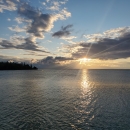The objective of this QAPP is to provide detailed procedures for Bighead and Silver Carp eDNA sample collection, sample processing, data analysis and interpretation, result reporting, and QA/QC procedures to ensure that data are as technically defensible, consistent, and usable as possible. The FWS Midwest and Northeast Regions will continue to maintain and update the QAPP for use in eDNA monitoring programs that allows for inclusion of any beneficial technical or strategic modifications that become apparent from past monitoring events, research, and/or relevant published literature vetted by FWS Midwest and Northeast Regions Fisheries and Aquatic Conservation (FAC) staff. Any eDNA samples collected and processed that do not follow the QAPP cannot be directly compared to FWS monitoring results. Therefore, the procedures outlined in the QAPP should be followed for eDNA monitoring and/or early detection of Silver and Bighead Carp by agencies and institutions that would like to compare their eDNA detection results to FWS results.
Publication date
Type of document
Plan
Facility
Media Usage Rights/License
Public Domain
Program
Species
FWS Focus
FWS Focus








